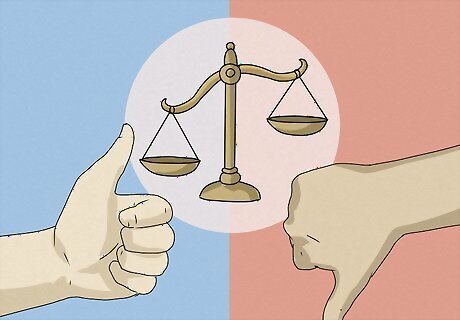
views
Identifying Your Feelings

Make a list of your feelings toward this person. Use the Problem Identification, Choices, Consequences (PICC) model to sort through your feelings. The first step is to identify all of the feelings you have about the person. Examples of feelings you might have toward a person might be intrigued, unsure, self-conscious, etc. Make a list of all the feelings you can identify. Be sure not to categorize these feelings as good or bad, such as in a pros or cons list. Just write them all out. Feelings are not “good or bad”; they all have a purpose. For example, your feelings toward a coworker or acquaintance might include bewildered, respectful, offended or exasperated. Your feelings toward someone close to you, such as your best friend or a family member, might include: love, disappointment, annoyed, comforted, and so on.

Think about a time you recently spent with this person. Identifying feelings can be difficult. It may help to start with a situation you remember and then add the feelings in after. Think of a recent time you spent with this person. Write a list of the feelings you had during this time. You may find that the feelings you identify are not because of who that person is or their relationship to us, but rather the situation you were in with them, or something specific they said or did. For example, you might go on a first date and have a good first impression. Then your date takes you to a party where you do not know anyone, and you feel uncomfortable or self-conscious. In this example, the situation or unfamiliar environment made you feel uncomfortable, not necessarily the person as a whole.

Identify what made you feel this way. There may be other factors that make you feel a certain way. It might not be entirely this person’s fault. Try to identify the specific source of each emotion. This is even more specific than identifying the situation. Think back to the moment you felt a certain way. Identify what was said or done immediately prior. For example, if you remember feeling rejected during a date, you might recall that you noticed your date moving away from you during a walk. This may have been the source of your feeling of rejection. Next to each emotion and situation on your list, write down what you think the source of the feeling was.
Separating Your Feelings From This Person

Examine your own feelings. Once you’ve identified your feelings about the person, and you’ve figured out the moment that you felt that way, you need to dig more deeply into these feelings. Your mixed emotions may have several different causes. Understanding these causes will help you resolve your mixed feelings. For example, if you have low self-esteem, you may not feel worthy of this person and therefore you won’t let yourself commit to a relationship.

Think about people in your past. A common reason why we have mixed emotions about someone is that this person reminds us of someone in our past. We may unconsciously assign certain qualities or expectations to a new person, based on our relationship and experience with the person in our past, in a process called “transference.” Your boss reminds you of your mean first-grade teacher, so you don’t like to follow your boss’ directions. Think about people in your life that made you feel a similar way as you feel now toward this new person. See if you can identify a similar pattern.

Consider how the other person treats you. Does this person treat you with respect? Is he abusive to you? When someone treats you nicely one minute and meanly the next, this can leave you confused with your own feelings. Think about how other people treat you. Do you get mixed feelings when another person treats you this way?

Be honest with yourself. Identifying your own feelings that may or may not be related to the other person is crucial for understanding how to deal with mixed feelings. Once you can separate your own feelings from the feelings that this person gives you, you might be able to identify your true emotions once and for all.
Finding a Solution

Write down the possible choices you can make. You now have a good idea of what caused each feeling you have about the person. Now you can determine your choices. Write down every way you might respond in this situation. Even if the choice is not ideal, write it down anyway. This will give you a full picture of your choices. For example, your list for a co-worker or acquaintance may look like this now: Feeling: Bewildered Situation: I was praised by a friend for a project I completed, but this same person criticized me an hour later. Possible choices: Approach the friend, keep it to myself, talk about it with my parents, start school gossip, tell the situation to my teacher, etc.

Identify possible consequences. Next to each choice, write down all the possible consequences or outcomes that you can think of. Your list may look like this: Choice: Approach friend about the issue Possible consequence: Friend becomes offended Possible consequence: Friend receives the message well Possible consequence: I feel vulnerable telling how the situation affected me Choice: Keep it to myself Possible consequence: The problem will continue Possible consequence: The problem may go away on its own Possible consequence: It will continue to bother me Choice: Talk to my parents about it Possible consequence: I will feel better about the situation Possible consequence: Nothing at school changes

Weigh the pros and cons. Evaluate the possible outcomes. Think about your level of comfort with each outcome. Consider how you will feel when you make the choice. Consider how the other person will feel.

Make a decision. Based on all the possible outcomes, choose one that you feel most comfortable with. This choice should be the one with the best outcome for yourself and the other person involved. Start with the choice that provides a needed outcome coupled with a consequence you are willing to experience. In the friend situation, for example, starting school gossip would probably not be ideal. The consequences could be painful or could jeopardize your relationship with other friends. At this moment, maybe you would like to start by keeping it to yourself. Maybe your friend had a bad day and took it out on you. Perhaps you were feeling sensitive that day. Be ready for the consequences you listed above.

If you aren’t satisfied, try another approach. If you find that keeping it to yourself does not provide the outcome you expected or needed, go back to your list of choices and try a different approach. Be sure that what you choose is respectful to you and others you are dealing with.
Seeking Help

Brainstorm with a trusted friend. It can help to have an outside perspective while coming up with possible choices and consequences. Ask a trusted friend to brainstorm with you to make your list.

See a counselor to resolve this particular situation. Explaining and defining emotions is a complex and often painful process. This is why the majority of work done in psychotherapy targets these issues. A therapist is trained in moving you through processes of deeper emotional clarity. They are also skilled at spotting aspects that don’t match up, which we are often unaware of. The subtleties can shed light on how you truly feel.

Address your own complex emotions. If you find that you are continually in a situation you cannot resolve, seek out professional help to work through your patterns. You may also want to seek help if you feel there is an unproductive pattern with how you approach situations. Additionally, if you find that a person or situation brings up feelings from the past, you will want to seek a professional to help you sort through your feelings. A therapist can help you identify complex emotions, even the emotions that are hard to admit. A therapist can aid you in obtaining the necessary skills to approach others in a productive way that is respectful to all parties.














Comments
0 comment